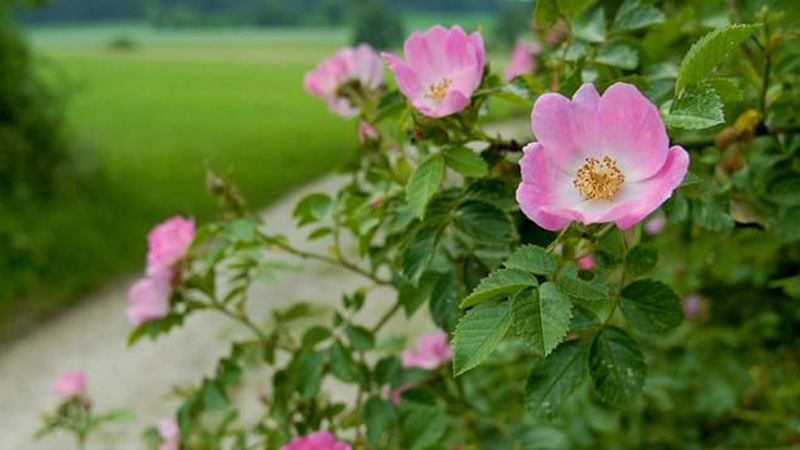Gardening is healthy for reasons we are probably not aware of. Because we garden during the daylight, we are exposed to the sun, and our bodies naturally produce Vitamin D from sunlight. Vitamin D protects against many types of cancer and heart disease. Gardeners also play in the dirt, which exposes us to soil-borne organisms such as natural bacteria, microorganisms and minerals that boost our immune systems. When asked, most gardeners say they garden for the relaxation and stress relief it brings, and that give us longer, healthier lives.
But what about long-lived garden plants? At over 1,000 years old, there is a Dog Rose or Rosa canina growing up the wall of the Hildesheim Cathedral in Germany. This hardy rose even survived Allied bombing raids in World War II with its roots protected under the debris.
Rosa canina is also called the Dog Rose, perhaps because it was once used to treat dog bites.
In the garden you will like Rosa canina for its delicate pinkish-white single flowers with a light old-fashioned rose scent. This is a tall climbing rose, easily reaching eight feet or more. These roses have long canes or branches that arch gracefully. The flowers are pale pink to white and bloom singly or in clusters of up to five flowers.
Although it only flowers once, in early summer, the real treat is the fruit. Dog Rose flowers soon give way to brilliant scarlet-red fruit, called hips. Rose hips contain antioxidants, such as vitamin C, vitamin E, beta-carotene and lycopene. These rose hips are said to be the most delicious of any rose.
Be aware that rose hips can cause certain drug interactions. This is probably because of the high concentration of vitamin C in rose hips.
To harvest rose hips, wait until as late in the season as possible before they begin to shrivel up. Toss out hips that are moldy, partly eaten or blemished. Choose only plump, dark red, shiny hips.
Never pick rose hips from bushes that have been sprayed with pesticides. Even after washing them thoroughly, toxins often remain.
Plant Rosa caninas a good 8 feet apart in full sun. This is a climbing rose, so provide it with strong support such as a trellis. Be sure that roses have good air circulation to prevent disease. Never use high-nitrogen fertilizers or you can encourage leaf growth with few flowers. Too much lush foliage growth can attract aphids.
Roses need soil with excellent drainage. Dig in a few shovels of compost and a good organic fertilizer. You may want to mulch to keep down weeds and grass.
Water your Dog Rose well after planting and and during any dry spells. Try to keep water from splashing onto the stems and leaves, as this can cause diseases. All roses will benefit from a teaspoon of Epsom salt to a gallon of water.
You probably will only need to prune Dog Roses to remove dead branches. If you must prune, only prune these climbers in the spring.
Cut branches at an angle, leaving a bud facing out from the bush, so the new growth will spread out naturally in a fan shape. Rosa canina is available from many nurseries or by mail from High Country Roses (800-552-2082, www.highcountryroses.com).
You can propagate Dog Rose by taking cuttings, or from seeds saved from the rose fruits, or hips.
Plant a Dog Rose (Rosa canina) and after a fragrant blush of flowers in early summer, watch the rose hips ripen from burnt orange to scarlet red. Plant them by your door or windows, so even in winter they can provide a splash of color. Who knows, your Dog Rose just might live 1,000 years.























































